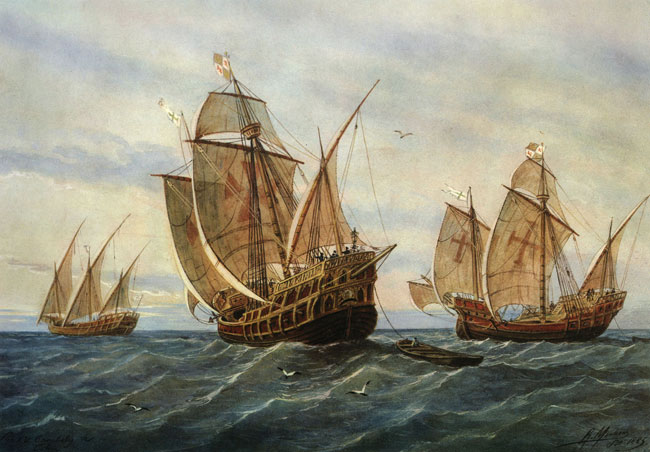Columbus Day and Voyage of Jean Baptiste Lapaise de Védrines
Columbus Day today is a holiday that observes the date when the famous Italian explorer Christopher Columbus discovered the New World of the Americas on an expedition sponsored by Queen Isabella and King Ferdinand of Spain in 1492. Columbus banked on the islands of what today is the Bahamas before going to what would later be Saint Domingue (Haiti) and Cuba.
The voyage of Columbus in 1492 paved the way for another voyage 250 years later that would bring Jean Baptiste Lapaise de Védrines from Europe to the New World as well. But unlike Columbus who went back and forth from Europe and returned there to live and die, Jean Baptiste Lapaise de Védrines remained in the new world, where he chose to live and die, leaving behind a large family. As we recall Columbus’ voyage today, it’s good to think about as well the voyage of the progenitor of all Vidrines in LA. We are blessed to know so much about his voyage because of the great work of Jacqueline Vidrine.
Jean Baptiste Lapaise de Védrines was commissioned as an Officer (Cadet a l’Aiguillette) in the Royal French Marines to serve in the LA Territory on May 29, 1742.
Eight months later, he boarded the Royal Vessel, La Charente with the newly-appointed governor of LA, Pierre de Rigaud de Vaudreuil de Cavagnial, Marquis de Vaudreuil for what would be a four month voyage.
In addition to the Charente and its supply ship the Vestale, there were at least three other ships destined for LA: the Lion d’Or of the Rasteau brothers, the Compte de Maurepas of Jean Jung of Bordeaux, and the Duc d’Aiguillon of Sieur Bourgine. (Governor Vaudreuil’s Voyage to Louisiana , p. 2) We’re able to know a few things about the voyage because of the logbook of the Lion d’Or’s second leg of the journey, from Saint Dominque to La Balize, beginning on April 9, 1743 (Governor Vaudreuil’s Voyage to Louisiana, p. 3).
On January 1, 1743, Jean Baptiste Lapaise de Védrines departed Rochefort, France on the Royal Ship La Charente with Gov. Vaudreuil and at least 41 passengers, not counting the domestic servants (Governor Vaudreuil’s Voyage to Louisiana, p. 9). Included were four Capuchin Priests (Governor Vaudreuil’s Voyage to Louisiana, p. 6).
We do not know anything about the trip from Rochefort, France to when the Charente docked at Saint Domingue on April 1-9, 1743 (Governor Vaudreuil’s Voyage to Louisiana, p. 11). But we do know that when it arrived at Saint Domingue, Captain Aubigny went to great expense to entertain Gov. Vaudreuil lavishly during the layover there (Governor Vaudreuil’s Voyage to Louisiana, p. 3).
There were two other Cadets d’Aguillettes who sailed with Jean Baptiste Lapaise de Védrines. One of them – Cadet Destre – was left behind at Saint Domingue when La Charente departed for New Orleans. Though they searched for him before leaving, he was never found (Governor Vaudreuil’s Voyage to Louisiana, p. 8).
The Charente landed at La Balize (mouth of the Mississippi River in LA south of New Orleans) on May 10, 1743. Governor Vaudreuil had been sick at sea 8 days before arriving (Governor Vaudreuil’s Voyage to Louisiana, p. 23). A few weeks later, they were received in the city of New Orleans, where Jean Baptiste Lapaise de Védrines would remain serving until the spring of 1751.
*See Governor Vaudreuil’s Voyage to Louisiana: The Passenger List of the Charente and the Navigational Logbook of the Lion d’Or for their Voyage of 1743, Vidrine, Jacqueline Olivier and Vidrine, Drouet Warren, fils, Drouet Warren Vidrine, San Clemente, CA, 2014

